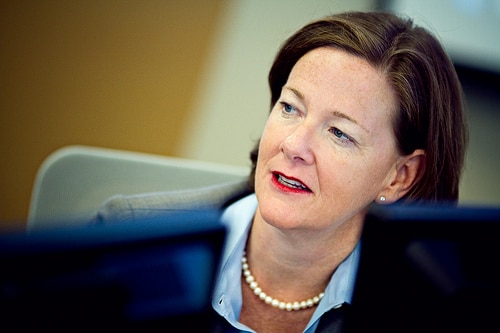This is the first post in a three-part series. For Part 2, How Redford Can Walk the Walk, click here. For Part 3, click here.
Within weeks of becoming Alberta’s first female premier in October 2011, Alison Redford realized that the tired old propaganda about jobs and Canada’s reputation as a safe and friendly supplier of oil wasn’t helping in the battle over the future of tar sands oil in America.
“We heard very quickly that they don’t want to hear anymore the security argument or the jobs argument. We get that,” Redford told the Globe and Mail. “Really, this is about environmental stewardship and sustainable development of the oil sands. We were quite happy to talk about that, [but] that was a shift in the kinds of conversations that Alberta was having.”
What Redford doesn’t seem to have understood is that it’s not about talking the talk, it’s about walking the walk. In a recent column in America’s biggest newspaper, USA Today, Redford tried to convince Americans that the proposed Keystone XL pipeline is part of Alberta’s “responsible oil sands development.”
Riffing off President Obama’s comments in his recent State of the Union address to get serious about dealing with the climate change crisis, Redford raved about Alberta’s “commitment to strong environmental policy and clean technology development,” even boasting that Alberta is “leading the way” in the global effort to reduce greenhouse gas (GHG) emissions.
Such nonsense is a familiar, if nauseating, refrain here in Canada. As the battle over the future of the Keystone XL pipeline heats up, Canadian politicians have resorted to the twisted Orwellian abuse of language to portray Alberta (and Canada) as responsible environmental stewards. Despite a mythical international reputation as such, nothing could be further from the truth, as Alberta’s climate change policy aptly illustrates.
Alberta released its Climate Change Strategy in 2008, which committed to reducing GHG emissions to 50 megatonnes below so-called business-as-usual (BAU) levels by 2020, and a total of 200 megatonnes below (BAU) levels by 2050. (This is equivalent to 14 per cent below 2005 levels, a far cry from Canada’s reduced commitment to reducing GHGs 17 per cent below 2005 levels by 2020.) The plan relies largely on capturing and sequestering carbon while allowing industrial development in the tar sands and elsewhere to continue along its steep trajectory into the stratosphere.
According to the Alberta government’s website, this climate change strategy reflects the government’s “strong commitment to maintaining a healthy economy, securing Albertans’ quality of life and protecting our environment.” In essence, it is Alberta’s blueprint for meeting the “challenge for policy and decision makers on both sides of the border” of “striking the right balance and moving our countries forward, together.”
So far so good, except that the Alberta government has failed miserably in achieving the “balance” set out in its climate change strategy, something Redford’s army of spin doctors must have known when they left it out of her USA Today column. Just two days after Redford put her reputation on the line in America’s biggest newspaper, the Alberta government was forced to admit that it won’t come close to meeting its targets for reduction of greenhouse gas emissions. “As of today we are not on the right trajectory to meet that commitment,” Alberta Environment deputy minister Dana Woodworth told the Public Accounts Committee. “We are actively looking at this exact issue as we speak.”
Woodworth’s admission is something of an understatement. According to the Pembina Institute, Alberta has contributed 52 per cent of Canada’s GHG emissions since 1990, despite being responsible for only 18 per cent of GDP growth and 19 per cent of the growth in population. This is in large part because, as Woodworth admitted, the province has reduced emissions by just 32 megatonnes over the past six years, an average of only five megatonnes a year. Alberta Environment has already admitted that by 2020, annual reductions will be about 14 megatonnes a year, a far cry from the 50 megatonne-a-year reduction stipulated in Alberta’s climate change strategy.
Image Credit: PremierofAlberta on flickr.
Subscribe to our newsletter
Stay up to date with DeSmog news and alerts







